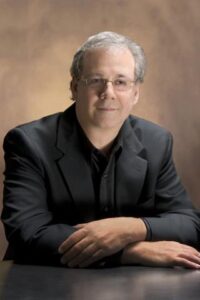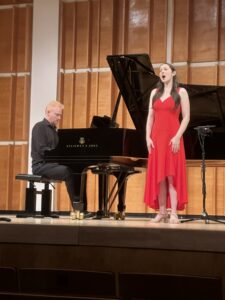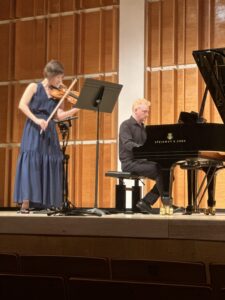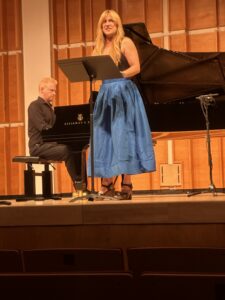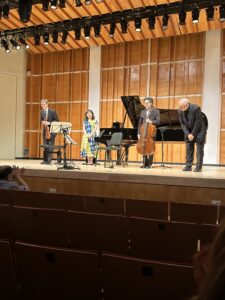Louis Karchin A Retrospective at Merkin Hall (concert review)
Louis Karchin: A Retrospective
Merkin Concert Hall
September 22, 2024
NEW YORK – Composer Louis Karchin has been prolific, even during the pandemic years. In a program at Merkin Concert Hall of chamber works and songs composed between 2018 and 2024, he was abetted by some of New York’s go-to new music performers, who acquitted themselves admirably throughout.
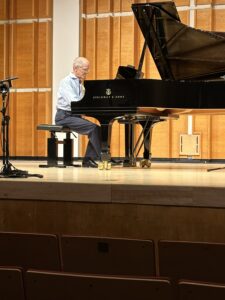
Stephen Drury is an abundantly talented pianist. But even with a repertoire list as lengthy and challenging as Drury’s, Sonata-Fantasia (2020, New York Premiere) is an imposing addition. The piece is in four large sections combined into a single movement, with elements such as chromatic and bitonal harmonies, chains of angular gestures, trills, and thrumming bass notes appearing frequently. One of the distinctive techniques employed pits a middle register chord repeated against impressionist sounding arpeggios cascaded above and below it. Apart from the meditative third section, sprightly virtuosity ruled the day.
Two Sacred Songs (2018, World Premiere) were workshopped via Zoom during the pandemic. Soprano Marisa Karchin and pianist Steven Beck performed these settings of George Herbert, a seventeenth century poet and Anglican priest. The soprano has radiant top notes, clear diction, and a sure sense of phrasing. “Denial” requires all of these characteristics, its wide vocal range matching the various emotions on display in the poem. Beck is a versatile pianist, who matched Marisa Karchin’s attention to the intricacies of the texts and provided vivid accompaniment. The two were a powerful pair when demonstrating the intensity of “The Storm.”
Beck frequently plays with instrumentalists too, and he performed Sonata quasi un Capriccio (2023, world premiere) with violinist Miranda Cuckson, a longtime collaborator of Karchin’s. This association benefited both piece and performance, as the composer knows how reliable Cuckson is, even in stratospheric altissimo lines. Sonata quasi un Capriccio is a white-hot piece filled with dramatic flair. It closed the first half.
The second half was also a mix of vocal and chamber music. The poet Steven Withrow heard Karchin’s music and was impressed. He approached the composer and suggested providing two texts based on paintings – San Vigilio: A Boat with a Golden Sail by John Singer Sargent and I And the Village by Marc Chagall – for Karchin to set as art songs, the result being Compositions on Canvas (2021, World Premiere). Soprano Alice Teyssier, joined by Beck, clearly reveled in the detailed texts, the first describing Sargent’s relationship to Italian patrons, the second detailing a virtual menagerie of animals found in Chagall’s painting. Karchin’s songs supply many coloristic shifts, dynamic gradations, and widely spaced gestures to encompass the imagery found in Withrow’s words. Teyssier navigated these handily, and Beck’s accompaniment glistened persuasively, particularly in the impressionist-simulating arpeggiations.
The concert concluded with a substantial work that, while maintaining Karchin’s musical language, provides a few hat tips to the concert tradition. Trio for Violin, Cello, and Piano (2019) was performed by the Horszowski Trio: Jesse Mills, violin; Ole Akahoshi, cello; and Rieko Aizawa, piano. Cast in three movements that run over twenty-five minutes, its first movement is marked Allegro con spirito and in sonata form. It begins with a mercurial upward arpeggio in the piano that references the opening gesture of Robert Schumann’s Piano Quintet. This is quickly countered by descending sixteenths. Gradually, lines compact into whorls of stacked thirds and seconds with trills adding zest. The presence of ascent is underscored by upward leaps in a subordinate theme in the cello. The tempo of the development shifts three times, slower and then quicker, with a misterioso section deconstructing the constituent themes. A recapitulation embellishes the material with even more scalar sixteenths, building in intensity until it closes with a forceful, registrally duplicated major third.
The second movement, marked Lento, begins with thirty-second note pile-ups and octave bass notes in the piano undergirding a sustained violin solo. A tremolando duet between the strings is succeeded by sul ponticello playing. The cello and piano imitate the violin’s sustained tune in canon against pulsating piano left hand octaves. A slow chain of rising, alternating intervals unveils a gradual reference to the first movement. Silvery piano arpeggiations and long chromatic ascent in the piano accompany the theme in several string variations.
The final movement, marked Vivace, begins with sustained low F octaves in the piano and a low F tremolando in the cello. The latter instrument adds short trills to abet a triplet-filled motive in the violin. These are succeeded by angular imitation in all three instruments, with the conflict between ascending and descending permutations of similar lines being restored. Pizzicato and trills in the strings are next set against the triplet passages in the piano, the variations in instrumentation opening a potent development section. Eventually, arpeggiations of seconds and fourths succeed the added note triads, and eighth note triplets once again propel the violin. A series of descending sustained bass notes in the piano are set against quarter note triplets in the strings, effectively stretching out the prior thematic material. This is followed by a kaleidoscopic reframing of all the motives from the third movement. The coda has a compound feeling, with quarter note and eighth note triplets overlaid and a fortissimo Bb major chord to conclude.
One of Karchin’s gifts as a composer is the ability to employ a relatively consistent musical language to a number of expressive ends. The variety of the program at Merkin Hall was impressive, as was the high quality of all of the music. One hopes that recordings of these pieces will soon be forthcoming.
-Christian Carey
